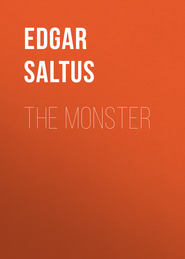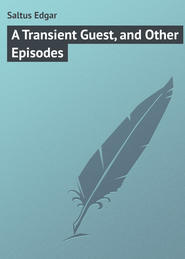По всем вопросам обращайтесь на: info@litportal.ru
(©) 2003-2024.
✖
The Lords of the Ghostland: A History of the Ideal
Настройки чтения
Размер шрифта
Высота строк
Поля
THE NEC PLUS ULTRA
IT was after fastidious rites, the heart entirely devout and on his knees, that Angelico di Fiesole drew a picture of the Christ. The attitude is emulative. It is with brushes dipped in holy water that Jesus should be displayed, though more reverent still is the absence of any delineation.
Reverence of that high character history formerly observed. There is no mention of the Saviour in the chronicles of those who were blessed in being his contemporaries. One indiscreet remark of Josephus has been recognized as the interpolation of a later hand, well-intentioned perhaps, but misguided. Jesus glows in the Gospels. Ye t they that awaited the day when, in a great aurora borealis, the Son of man should appear, had passed from earth before one of the evangels was written.
It was a hundred years later before the texts that comprise the New Testament were complete. It was nearly two hundred before they were definitive. In the interim many gospels appeared. Attributed indifferently to each of the Twelve, one was ascribed to Judas. There was a Gospel to the Hebrews, a Gospel to the Egyptians. There were evangels of Childhood, of Perfection and of Mary.
These primitive memoirs were based on oral accounts of occurrences long anterior. Into them entered extraneous beauties, felicities of phrase and detail, which, with naïf effrontery, were put into the mouth of one apostle or another, even into that of Jesus. The ascription was regarded as highly commendable. It was but a way of glorifying the Lord. Besides, the scenarii of these pious evocations the prophets had traced in advance.
"Rejoice, daughter of Zion; shout, daughter of Jerusalem, behold thy King cometh unto thee; he is just and having salvation, lowly and riding upon an ass."
That king of the poor whom Zachariah had foreseen, the stumbling block of Israel that Isaiah had foretold, the Son, mentioned by Hosea, whom Jahveh had called out of Egypt, was the Saviour, ascending in glory as Elijah had done. A passage incorrectly rendered by the Septuagint indicated a virginal birth. That also was suggestive.
The little biographies in which these developments appeared were intended for circulation only among an author's narrow circle of immediate friends, at most to be read aloud in devout reunions. If, ultimately, of the entire collection, four only were retained, it is probably because these best expressed existing convictions. Though, irrespective of their beauties, Irenæus said that there had to be four and could be but four, for the reason that there are four seasons, four winds, four corners of the earth, and the four revelations of Adam, Noah, Moses, and Jesus.
It is not on that perhaps arbitrary deduction that their validity resides, but rather because the parables and miracles which they recite became the spiritual nourishment of a world. To their title of eternal verities they have other and stronger claims. They have consoled and they have ennobled. Elder creeds may have done likewise, but these lacked that of which Christianity was the unique possessor, the marvel of a crucified god.
Saviours there had been. Mithra was a redeemer. Zoroaster was born of a virgin. Persephone descended into hell. Osiris rose from the dead. Gotama was tempted by the devil. Moses was transfigured. Elijah ascended into heaven. But in no belief is there a parallel for the crucifixion, although in Hindu legend, Krishna, a divinity whose mythical infancy a mythical prototype of Herod troubled, died, nailed by arrows to a tree.
In Oriental lore Krishna is held to have been the eighth avatar of Vishnu, of whom Gotama was the ninth. Krishna was therefore anterior to the Buddha, at least in myth. But it would be a grave impropriety to infer that with the legend concerning him the narrative of the crucifixion has any other connection than the possible one of having suggested it. The Bhagavad-Purana, in which the legend occurs, is relatively modern, though the legend itself may, like the Tripitaka, have existed orally, for centuries, before it was finally committed to writing.
There can, however, be no impropriety in recalling analogies that exist between the Saviour and one whom the Orient holds also divine. These analogies, set forth in the first chapter of the present volume, are, it may be, wholly fortuitous, though Pliny stated that, centuries before his day, disciples of Gotama were established on the Dead Sea and, from a passage in Josephus, it seems probable that the Essenes were Buddhists, in the same degree perhaps that the Pharisees were Parsis. But the point is also obscure. It is immaterial as well. The Gospels were not written in Jerusalem but mainly in Rome, where crucifixions were common, as they were, for that matter, throughout the East, but where, too, all religions were acclimated and the supernatural was at home.
Rome had witnessed the tours de force of Apollonios of Tyana. Those of Simon the Magician had also been beheld. Rome had seen, or, it may be, thought she believed she had seen, Vespasian cure the halt and the blind with a touch. The atmosphere then was charged with the marvellous. The temples were filled with prodigies, with strange gods, beckoning chimeras, credulous crowds.
There was something superior. Rome was the depository of the legends and lore of the world. A haunt of the Muses, the sensual city was a hermitage of philosophy as well. These things collectively represented a great literary feast, of which not all the courses have descended to us, though, as is not impossible, a lost dish or two, transmuted, by the alchemy of faith, from dross into gold, the Gospels may perhaps contain.
In that case there is cause for great thankfulness. Moreover, assuming the transmutation, no impiety can be implied. It was as usual and as indicated as were papyrus and the stylus. It is common to-day for a poet, before spreading his own wings, to contemplate those of another. Inspiration is infectious.
A page of verse, whether Hindu, Persian, Egyptian, Greek, or Latin, was as useful then. Dante fed on the troubadours. They are lost and forgot. He divinely stands greater than the tallest of them all. In a measure the same may be true of those from whom the Gospels came. Yet with a very notable difference. The Divina Commedia was written for all time. So too were the Gospels. But not intentionally. They were written to prepare man for the immediate termination of the world. With the most perfect propriety, therefore, anything serviceable could have been utilized and probably was. The devout had but to lift their eyes. In the words of Isaiah, there, before them, were the treasures of nations; there were the camels and dromedaries bearing from every side incense and gold; there were the sons of strangers to build up their walls.
The sons were many, the treasures as great. Even otherwise there was the Law, there too were the Prophets. Moses fasted for forty days. Elisha performed a miracle of the loaves, if he did not that of the fishes. Job saw the Lord walking upon the sea. Jeremiah said: "Seek and ye shall find." Isaiah bid those that sorrowed come and be consoled. In the poem of that poet the servant of the Lord had vinegar when he thirsted, he was spat upon and for his garments lots were cast.
In an effort to fill in a picture of which the central figure had passed from the real to the ideal, these things may have been suggestive. So also, perhaps, was the Talmud. The redaction of that chaos began in the second century. But the Vedas, the Homeric poems, the Tripitaka as well, existed in memory long before they were committed to writing. The same is true of the Talmud. Orally it existed prior to the Christ. Considered as literature, if it may be so considered, it is the reverse of endearing. But of the many maxims that it contains there are some of singular charm. Among others is the Lay not up for yourselves treasures on earth.[65 - Talmud Babli: Baba bathra, 11 a.] The origin of that, as already indicated, is traceable to the Tripitaka, which, parenthetically, were so well known in Babylon that Gotama was there regarded as a Chaldean seer. That abridgement of the Law which is called the Golden Rule is also in the Talmud,[66 - Schabbath, 37 a.] as also, before the Talmud was, it was in the Tripitaka. The injunction to love one's enemies is equally in both. So is the very excellent suggestion that one should consider one's own faults before admonishing a brother concerning his defects. But the perhaps subtle intimation that the desire to commit adultery is as reprehensible as the act, and the rather extravagant statement that it is easier for a camel to pass through the eye of a needle than for a rich man to enter the kingdom of heaven, these, originally, were perhaps uniquely Talmudic. Currently cited with multiple others they were all so many common sayings, which, strung together in the Gospels, became a rosary of most perfect pearls.
In a passage of Irenæus it is stated that the Gospel according to St. Matthew was arranged by the Church for the benefit of the Jews who awaited a Messiah descended from David. A Syro-Chaldaic evangel, known as the Gospel to the Hebrews, had then appeared. So also had the Gospel according to St. Mark. But these offered no evidence that Jesus was the one they sought. Another was then prepared. Written in Greek and bearing the authoritative name of Matthew, it traced from David, Joseph's descent.
The narrative continued: "Now the birth of Jesus Christ was in this wise. When as his mother Mary was espoused to Joseph, before they came together, she was found with child by the Holy Ghost. Then Joseph her husband being a just man and not willing to make her a publick example, was minded to put her away privily. But while he thought on these things, behold, the angel of the Lord appeared unto him in a dream, saying, Joseph, thou son of David, fear not to take unto thee Mary thy wife: for that which is conceived in her is of the Holy Ghost."
The genealogy completed, though perhaps inadequately, since Jesus, not being a son of Joseph, could not have descended from David, the Church continued: "Now all this was done that it might be fulfilled which was spoken of the Lord by the prophet saying, Behold a virgin shall be with child and shall bring forth a son and call his name Emmanuel."
The prophecy mentioned occurs in Isaiah vii, 14. In the King James version it is as follows: "Behold a virgin shall conceive and bear a son and shall call his name Immanuel." But the Aramaic reading is: "Behold an 'almâ shall conceive." 'Almâ means young woman. The Septuagint, in translating it, employed the term [Greek: parthenos], or maiden. In Matthew the term was retained.
Matthew, at the time, had long been dead. Even had he been living it is improbable that he could write in Greek. Unfortunately there were others who could not only write Greek but read Hebrew. In particular, there was a rabbi Aquila who retranslated Isaiah with no other purpose than the malign object of definitely re-establishing the exact expression which the old poet had used.[67 - Renan: Les Evangiles.]
It was presumably in these circumstances that the Evangel of Mary was advanced. Among other elucidations, the work contained professional testimony of the immaculacy that was claimed. Additionally, in reparation of the earlier oversight, the Virgin was genealogically descended from the royal line.
That, however, is apocryphal, and if, regarding the other genealogy, exegesis has since obscured the luminousness of the method adapted by the Church, the latter's intention was none the less irreproachable, and that alone imports. Before it, before the miracle of the nativity and the divine episodes of the transfiguration, crucifixion, resurrection, and ascension, reverently the Occident has knelt. They are indeed divine. If they did not occur in Judea, they have occurred ever since. Continuously, in the hearts of the devout, they are repeated.
Unhappily there were heretics then as now. To the Gnostics, Jesus was an æon that had never been. To the Docetists, he was a phantasm. There are always brutes that can believe but in the reality of things. There are others to whom the symbolic is dumb. In the Gospels there is much that is figurative, there is more that is ineffable, there are suggestions sheerly ideal.
"In my Father's house are many mansions," the Saviour declared. In his own ministry there are as many lights. He was a vagrant and he created pure sentiment. He was a nihilist and he inspired a new conception of life. He said he had not come to destroy and he changed the face of the earth. He remitted the sins of a harlot and condemned both marriage and love. There are other antitheses, deeper contradictions. These perhaps are more apparent than real. Behind them there may have been the co-ordination of a central thought. Of many gospels but few remain. Among the lost evangels was one that Valentinian said was imparted only to the more spiritual of the disciples. It may be that in it a main idea was elucidated and, perhaps, as a consequence, the meaning of the esoteric proclamation: "Before Abraham was I am."
Yet though now the authoritative explanation be lacking, its significance seems to run beneath the texts. At the first apparition of Jesus, the chief preoccupation of those that stood about was what prophet of the old days had returned in the new. Some thought him Elijah. Others Jeremiah. Antipas feared that he was the Baptist revived. Jesus himself asked the disciples whom he was said to be. Later he assured them that the awaited return of Elijah had been accomplished in John. That assurance, together with the perplexities regarding him and the esoteric announcement which he made concerning himself, can hardly indicate anything else than a belief in reincarnation.
The belief, common to all antiquity, though not necessarily valid on that account, is not discernible in Hebrew thought, perhaps for the reason that it is not perceptible in Babylonian. Yet the myth of Eden barely conceals it. It is almost obvious in the allegory of Beth-el. Solomon said: "I was set up from everlasting, from the beginning or ever earth was." If the idea contained in that statement was not a part of the philosophy attributed to the Christ, it might have been. The amount of beauty stored in it is more enormous than in any other.
To the materialist the beauty is meaningless. To the mathematician it has the value of a zero from which the periphery has gone. But at the Pillars of Hercules early geographers put on their maps: Hic deficit orbis– Here ends the world. They had no suspicion that beyond that world there stretched another twice as great. Materialists may be equally naïf. On the other hand, they may not be. The theory of reincarnation is one that transcends the limits of experience.
Of the many tenets of the belief there are but two with which the matter-of-fact agrees. One of them concerns the conservation of energy, the other the negation of death. Theory and practice unite in admitting that the supply of energy is invariable. Constantly it is transformed and as constantly transposed, but whether it enter into fungus or star, into worm or man, the loss of a particle never occurs. Death consequently is but the constituent of a change. When it comes, that which was living assumes a state that has in it the potentiality of another form. A tenement has crumbled and a tenant gone forth. Though just where is the riddle.
In the thousand and one nights that were less astronomic than our own, it was thought that the riddle was answered. Poets had erected an edifice of verse and called it Creation. In the strophes of the epic the earth was a flat and stationary parallelogram. About the earth, and uniquely for its benefit, sun, moon and stars paraded. Above was a deity one or multiple. Below were places of vivid discomfort. To the latter, or to the former, the soul of man proceeded. There were no other resorts. Creation had its limits.
Poets younger yet more gray have presented a different conception. In the glare of a million million of suns they have sent the earth spinning like a midge. Beyond the uttermost horizon they have strewn other systems, other worlds; beyond the latter, more. Wherever imagination in its weariness would set a limit, there is space begun.
There too is energy. Throughout the stretch of universes the same force pulsates that is recognizable here. A deduction is obvious. Throughout infinity are sentient beings, perhaps our brothers, perhaps ourselves.
The obvious, very frequently, is misleading. But the dream of precipitation into that wonderful tornado of worlds has the merit of more colourful idealism than that which was formerly displayed. Taken but as an hypothesis, it holds suggestions ampler than any other conveys. It intimates that just as the butterfly rises from the chrysalis, so does the spiritual rise from the flesh. It indicates that just as the sun cannot set, so is it impossible for death to be.
There are topics about which words hover like enchanted bees. Death is one of them. Mediævally it was represented by a skeleton to which prose had given a rictus, poetry a scythe, and philosophy wings. From its eyries it swooped spectral and sinister. Previously it was more gracious. In Greece it resembled Eros. Among its attributes was beauty. It did not alarm. It beckoned and consoled. The child of Night, the brother of Sleep, it was less funereal than narcotic. The theory of it generally was beneficent. But not enduring. In the change of things death lost its charm. It became a sexless nightmare-frame of bones topped by a grinning skull. That perhaps was excessive. In epicurean Rome it was a marionette that invited you to wreathe yourself with roses before they could fade. In the Muslim East it was represented by Azrael, who was an angel. In Vedic India it was represented by Yama, who was a god. But mediævally in Europe the skeleton was preferred. Since then it has changed again. It is no longer a spectral vampire. It has acquired the serenity of a natural law. Regarding the operation of that law there are perhaps but three valid conjectures. Rome entertained all of them. There, there was a tomb on which was written Umbra. Before it was another on which was engraved Nihil. Between the two was a portal behind which the Nec plus ultra stood revealed.
The portal, fashioned by the philosophy of ages, still is open, wider than before, on vaster horizons and unsuspected skies. Through it one may see the explication of things; the reason why men are not born equal, why some are rich and some are poor, why some are weak and some are strong, why some are wise and many are not. One may see there too the reason of joys and sorrows, the cause of tears and smiles. One may see also how the soul changes its raiment and how it happens to have a raiment to change. One may see all these things, and others besides, in the revelation that this life, being the refuse of many deaths, has acquired merits and demerits in accordance with which are present punishments and rewards.
In proportion as these are utilized or disregarded, so perhaps is retrogression induced or progress achieved. But not in Hades or yet in Elysium. These were the inventions of man for his brother. So also was the very neighbourly heaven which the early Church devised. But because that has gone from the sidereal chart, it does not follow that there is no such place. Because there is nothing alarming under the earth, it does not follow that hell has ceased to be. On the contrary. Both are constant, though it be but in the heart.
In the light of reincarnation it is probable that neither can occur there without anterior cause. But probably too it is the preponderance of either that creates the mystery of life, as it may also foreshadow the portent of death.
Death, it may be, is not merely a law but a place, perhaps a garage which the traveller reaches on a demolished motor, but whence none can proceed until all old scores are paid. Pending payment, there, perhaps the soul must wait. But the bill of its past acquitted, it may be that then it shall be free to pursue on trillions of spheres the diversified course of endless life – free to pass from world to world, from beatitude to bliss, from transformation to transfiguration, from the transitory to the eternal; weaving, meanwhile, a garland of migrations that stretch from sky to sky, marrying its memoirs with those of the universe, and, finally, from some ultimate zenith, reviewing, as it casts them aside, the masks of concluded incarnations.
The prospect, overwhelming in beauty, is really divine. The divine is always utopian. But there is the supreme Alhambra of dream. It exceeds any other, however excessive another may be. It is the Nec plus ultra. Into it all may wander and never weary of the wonders that are there. It may be unrealizable, but for that very reason it must be also ideal.
FINIS HISTORIÆ DEORUM
notes
1
Luke vii. 37-50. Sacred Books of the East, xi. 30.
2
Matthew xi, 19. S. B. E. xiii. 92.
3
Matthew vi. 19. S. B. E. x. 191.
4











